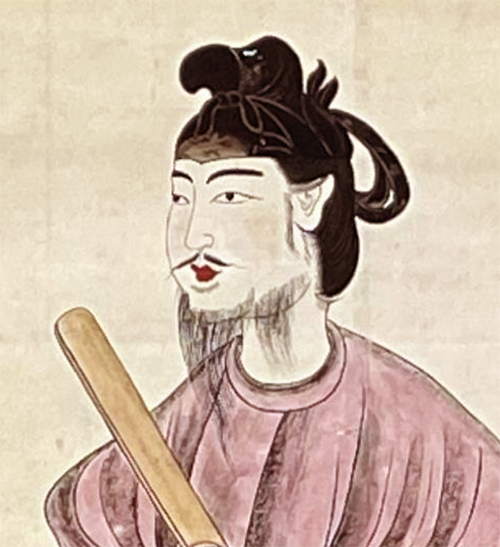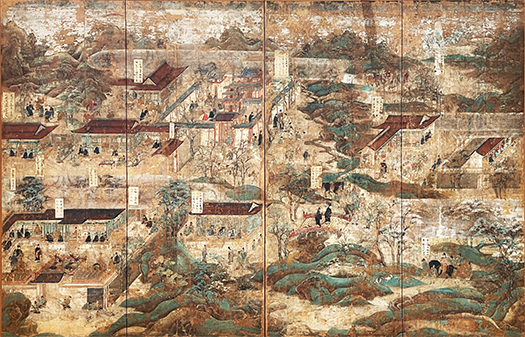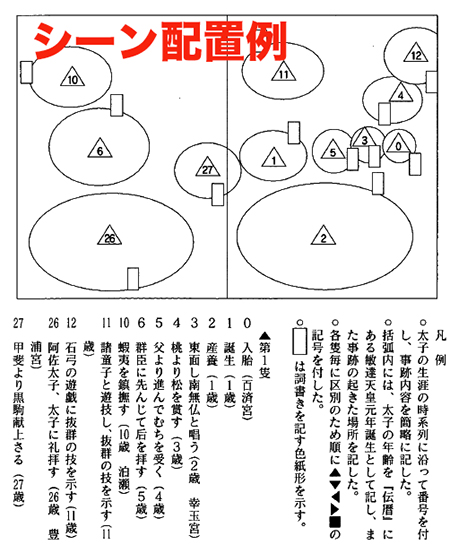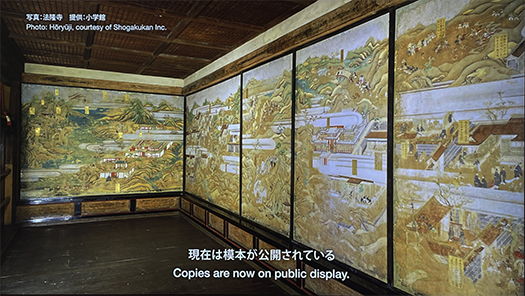
昨日建築を紹介した「法隆寺宝物館」。東京上野の東京国立博物館敷地の奥にある展示施設。明治11年に法隆寺から皇室に献上された宝物群を展示公開。いわば国民共有の文化財産。当然、私的所有という概念には似つかわしいものではなく、すべて共有されている。歴史的に貴重な知的文化資産を民が共有し、その価値感を進化発展させるのは民主主義の基本だと思う。
宝物館には多数の仏像などの品々が展示されているけれど、ちょうど訪問したとき「聖徳太子絵伝」のデジタル公開が行われていた。日本人と法隆寺、そしてその核心に存在する「聖徳太子信仰」がいきなり直球で展示されていた。
日本の王権が諸外国のような革命政変ではなく、比較的に温和なカタチで王権と政権の分離というような柔軟な政権交代を実現してきた根源には「鎮護国家」思想の成功、広い民衆の支持があると思う。「篤く三宝を敬え」とされる仏教政策を順守してきたことで、社会崩壊の危機を乗り越えてきた。皇統が少なくとも千数百年存続してきたことは、世界の奇跡。聖徳太子はその実在について論争があるけれど、王権の正統性根拠において枢要な存在だと思う。


その太子の生涯を伝える「聖徳太子絵伝」は1069年・平安時代に制作された絵画。上の絵はデジタル処理された現存の絵伝の内の一幅。多数の太子の事跡が時系列がやや前後しながらまるで迷路のように描画されている。アメリカの哲学者、ネルソン・グッドマン氏によると「全体として60の事跡がねじれた物語として構成されている」。不思議な絵画構成感覚といえるだろうか。
法隆寺創建(607年)からは相当の歴史経過を経ている。この時期に法隆寺では「舎利殿」とともに「絵殿」が新設され、その絵殿にこの絵画が障壁画のようにぐるっと一覧展示されていたのだとされる。

いまは模画が法隆寺絵殿に写真のように展示されているという。法隆寺の記録にはこの制作経緯についても明確な記述があり、絵師は摂津国大波郷の住人・秦致貞と明記されている。
まことにタイムトラベル風に時代回想を呼び起こされる(笑)。世は藤原氏の摂関政治全盛期ということができる。天皇家王権は象徴的存在であり、それを統御するシステムとして貴族層の頂点に藤原氏が存在していた時代。ただ、そういう藤原氏の政権独占に対して院政を対置して王権の執政回復を狙った白河帝がこの時期、皇太子になっている。やがて武士の興隆を招く直前の時代だろう。
そういう時代の中で、法隆寺としては日本仏教の根源地として、その創建に深く関わった聖徳太子の事跡を広く広報することで、日本社会での格別な地位を維持発展させようとしたものだろうか。また、平安後期には成立していた「郷絵師」秦致貞という存在にも強く興味を掻き立てられる。〜以下つづく。
<参考/金沢美術工芸大学紀要・大田昌子氏「法隆寺絵殿本・聖徳太子絵伝の語りの構造」>
English version⬇
Digital “Shotoku Taishi E biography” in The Gallery of Horyuji Treasures-2
The miraculous acceptance of Buddhist thought in Japanese society as a “state of tranquility and protection”. What is the “faith” of Horyu-ji Temple and its founder, Prince Shotoku? …
The Gallery of Horyuji Treasures, whose architecture was introduced yesterday. This exhibition facility is located at the rear of the Tokyo National Museum grounds in Ueno, Tokyo. The museum exhibits and displays a group of treasures presented to the imperial family by Horyuji Temple in 1878. In other words, the treasures are the common property of the people. Naturally, it does not resemble the concept of private ownership, but is entirely shared. It is the basis of democracy for the people to share historically valuable intellectual and cultural assets and to evolve and develop their sense of value.
The Treasure House has many Buddhist statues and other items on display, and when I visited the museum, the “Shotoku Taishi Eden” was being digitally displayed. The Japanese people, Horyu-ji Temple, and the “Shotoku Taishi faith” that exists at the core of the temple were suddenly on display in a direct manner.
I believe that the success of the “Shinko-no-Kokoku” philosophy and the broad support of the people are at the root of the flexible change of government in Japan, where the separation of power and administration has been achieved in a relatively mild manner, rather than through revolutionary changes of government as in other countries. The adherence to the Buddhist policy of “reverence for the three treasures” has helped the country to overcome the crisis of social disintegration. The fact that the imperial lineage has survived for at least a thousand years is a miracle of the world. Although there is some controversy over the existence of Prince Shotoku, I think he is a pivotal figure in the basis of the legitimacy of royal authority.
The “Shotoku Taishi E biography” tells the story of the life of Prince Shotoku, a painting created in 1069 during the Heian period (794-1185). The painting above is one of the existing digitally processed paintings. It is a labyrinth of numerous traces of the Taishi, with the chronological order of events slightly backward and forward. According to Nelson Goodman, an American philosopher, “Sixty events are arranged as a whole in a twisted narrative,” which is a curious sense of composition.
A considerable amount of history has passed since the founding of Horyuji Temple (607). It is said that the paintings were exhibited in the E-den (Picture Gallery), which was newly built along with the Shariden (Hall of Relics) at Horyu-ji during this period, and that the paintings were displayed in the E-den like a wall painting.
A reproduction of the painting is now on display in the Horyuji Picture Hall, as shown in the photo. The Horyuji record clearly describes how the painting was created, and the painter is clearly identified as Hata Chisada, a resident of Ohnami, Settsu Province.
It is truly a time traveler’s recollection of the times (laughs). The era can be said to be the heyday of the Fujiwara family’s regal government. The emperor’s royal authority was symbolic, and the Fujiwara clan existed at the top of the aristocratic class as a system to control it. However, the Emperor Shirakawa, who aimed to restore the royal regency by countering the Fujiwara’s monopoly of power with the Insei government, became the crown prince during this period. This was probably the period just before the rise of the samurai.
In such an era, Horyu-ji Temple, as the root of Buddhism in Japan, may have sought to maintain and develop its exceptional status in Japanese society by widely publicizing the memory of Prince Shotoku, who was deeply involved in its founding. The existence of Hata Chisada, a “goeji” painter who was established in the late Heian period, also arouses strong interest. To be continued.
<Reference: Kanazawa College of Art Bulletin, Masako Ota, “Narrative Structure of the Illustrated Biography of Shotoku Taishi in the Horyuji Eden Hon” >.
Posted on 5月 30th, 2023 by 三木 奎吾
Filed under: 日本社会・文化研究







コメントを投稿
「※誹謗中傷や、悪意のある書き込み、営利目的などのコメントを防ぐために、投稿された全てのコメントは一時的に保留されますのでご了承ください。」
You must be logged in to post a comment.